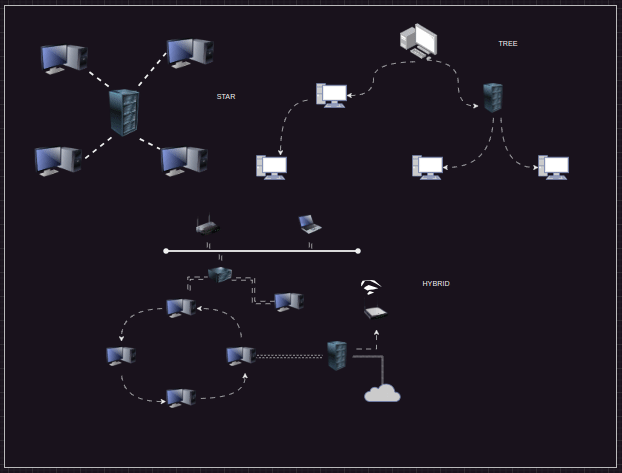
What is Network Topology?
A network Topology refers to the physical or logical layout or arrangement of connected devices(nodes) in a computer network. The network topology influences the efficieny, reliability, and scalability of a network.
>> Certainly we have different network topologies discussed below:1. BUS TOPOLOGY
In a bus topology, all devices share a single communication line (the bus). Data is transmitted along the bus with each end consists of a terminator.
Advantages:
- Simple and easy to implement.
- Cost-effective for small networks.
Disadvantages:
- Performance degrades as more devices are added.
- If main cable fails entire network will be affected.
2. STAR TOPOLOGY
In a star topology, all devices are connected to a central hub or switch. The hub(or switch) manages and controls communcation between nodes.
Advantages:
- Centralized management and easy troubleshooting<./li>
- Issues with one device(node) do not affect other nodes.
Disadvantages:
- Dependancy on the central hub, its failure will affect the entire network.
- Expensive to implement for larger networks as n-cables will be required for n-nodes
3. RING TOPOLOGY
In a ring topology, devices are connected in a cicular fashion(arrangement). Data can move uni or bi directional, passing throung each node until it reaches its destination.
Advantages:
- NO collions in data transmission.
- Simple and easy to install.
Disadvantages:
- Performance degrades as more devices are added.
- Failure of one device or cable can disrupt the entire network.
4. MESH TOPOLOGY
In a mesh topology, every device or we can say every node is completely connected to every other node, creating multiple paths for data transmission.
Advantages:
- Failure of one link does not affect the entire network.
- Every node is indepented for sending data.
- Flawless and reliable communication.
- Redundancy and reliability with multiple communication paths.
Disadvantages:
- Very expensive compare to other topologies.
- Complex to manage and configure.
- Lots of cabling is required for creating multiple paths.
5. HYBRID TOPOLOGY
A hybrid topology is a combination of two or more different topologies. It can be a combination of [bus and ring] , [star or mesh] etc.
Advantages:
- Offer flexibility and customization.
- Can meet enterprize needs.
- More computers (nodes) can be connected, as workload distributes.
6. TREE TOPOLOGY
A tree topology is a combination of (two fast and simple) star and bus topologies, forming a hierarchical struture.
Advantages:
- Scalibility with hierarchical structure.
- Centralized management system.
- Simple and easy to configure and troubleshoot.
Disadvantages:
- Dependancy on the central hub or the root node.
- Issues with the root node can affect the entire branch.
- Its crucial for the root node to work properly.